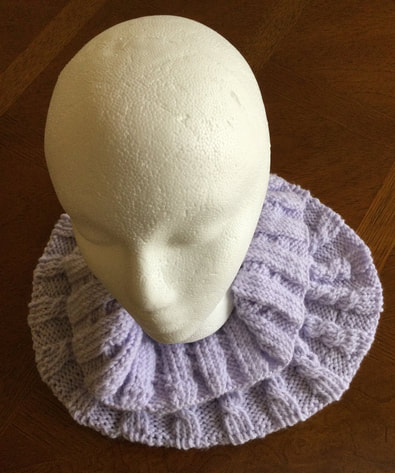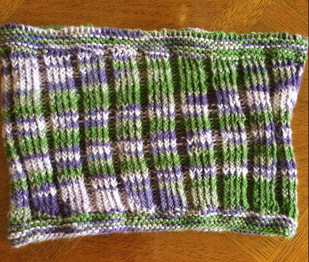 Fellow knitters, as promised I am sharing my experiments with knitted cowls that you can use to add style to the simplest outfit. By experiments, I mean that none of the cowls featured in this article came from a single specific pattern. My process included reading through many knitted cowl patterns to establish realistic size and stitch counts for completed cowls. Then I combined stitch patterns that I have used successfully to produce other garments. Now that I have taken notes and have examined the finished pieces I can move on to make changes in size and pattern. I have had a lot of fun and am eager to share my work with you.  My ribbed cowl was knitted in the round with a self striping worsted weight yarn on #8 cable needles. The piece measures 9 inches high and has a circumference of 22 inches. Cast on 130 stitches. To produce the cowl, begin with 6 rows garter stitch (knitted) The stitch pattern is a rib with a 4 knit 2 purl repeat. To increase the circumference add in multiples of 6 for the 4 knit stitches and the 2 purl stitches. Since the piece is knitted in the round, you just continue with the same stitch pattern until you have the desired height. Complete the cowl with 6 rows of garter stitch.  1 love the texture of the bamboo stitch cowl. I have used this stitch to make fingerless gloves and scarves. The cowl is 8 1/2 inches high with a circumference of 20 inches. However the stitch is quite stretchy which makes it very comfortable. The piece was knitted with a #3 merino self striping yarn on #* cable k=needles. Place marker at beginning of row, The 4 row repeat pattern continues as follows: Row 1: *Slip 1, knit 2 Pass the slip stitch over the two knitted stitches. Purl 2.* Continue to end of row. Row 2: *Knit 1. Add 1 stitch before the next knitted stitch. Knit 1. This addition replaces the stitch lost be slipping a stitch over the two knitted stitches in row 1. Purl 2.*Continue to marker. Row 3: Knit. Row 4: Knit. Cast on 130 stitches. There is a 5 stitch multiple to add or decrease stitches.The first 6 rows will establish the rib. Knit 3 stitches Purl 2 stitches. Starting in row 7 begin with the stitch repeat. I knitted 9 4 row pattern repeats. Complete cowl as you began with a 6 row rib of 3 Kinit 2 Purl. The finished cowl was cozy and soft. If I were to repeat the pattern, I would probably add ten to twenty stitches for a looser fit.  The final cowl was probably my favorite. The pale lavender Impeccable worsted from Micheals was knitted on a #8 cable needle in the round. The design feature for this cowl was aC4 cable stitch. To produce this stitch, slip 2 stitches on a cable needle.in front of work. Knit the next two stitches. Knit the two stitches from the cable needle. How to Knit the 4 Stitch Cable is a helpful You Tube Video that can guide you through the process. Cast on in multiples of 8. I cast on 160 stitches for my piece. Place a marker before the first stitch. To establish rib, I knitted 4 purled 4 around to end for 4 rows. Pattern sequence is as follows: Row 1: *Follow steps for C4F or cable stitch with 4 stitches in which you hold the cable needle to the front. Purl 4* and continue around. Rows 2-4 Knit. Continue with sequence until you have the desired height. Endwith 4 rows of knit 4, purl 4 ribbing. I enjoyed this simple cabling. In future cowls I may wish to work on more complicated combinations. Creating a cowl is so satisfying as the project can be completed quickly and the creative possibilities are endless. After my initial experiments I am encouraged to try new designs during the autumn or winter months.
As always I appreciate your reflections and feedback. Thank you for joining me on my stitching journey.
0 Comments
Leave a Reply. |
Archives
November 2022
Categories
|





 RSS Feed
RSS Feed